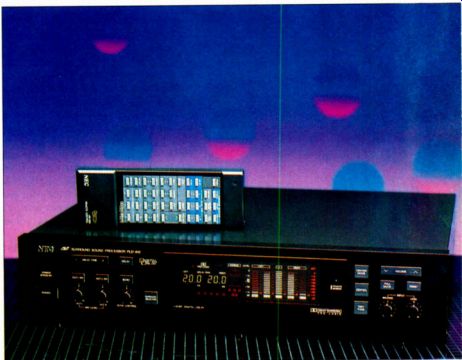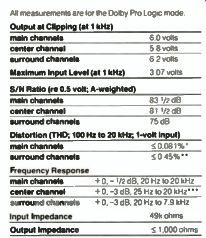
The PLD-910 is not the first NEC surround-sound
processor we've reviewed, nor is it the first processor to use digital
delay. But it is NEC's first to incorporate Dolby Pro Logic and one of
the most up-to-date we have seen.
The PLD-910 is the first processor we can recall with double-oversampled 16 bit analog-to-digital (A/D) conversion (at a data rate of 88.2 kHz) and quadruple-oversampled 16-bit digital-to-analog (D/A) conversion (at a rate of 176.4 kHz). Oversampling makes it possible to use digital input as well as digital output filters, and these, in turn, are said to pro vide smoother frequency and phase response to 20 kHz.
The Dolby Surround buff may greet the above statement with a resounding "So what?" since the surround channel (the only one that passes through the PLD-910's digital delay line) is band limited to 7 kHz by the Dolby standard anyway. That's true enough, but the PLD-910 is more than simply a Dolby Surround processor. In its "Creation" mode it serves as a full-bandwidth surround-sound simulator by creating an extra pair of channels from the original stereo pair.
Creation is an apt description of the PLD-910's alternate mode. Unlike some other digital signal processors that are preloaded with simulated patterns, the PLD-910 lets you roll your own from the tools provided: adjustable front-to-back delay, from 1 to 94 milliseconds in 0.1 millisecond increments; echo, to create a reverberation effect; and adjustable left/ right crossfeed. The amount of crossfeed between front and rear channels is in dependently adjustable by front-panel mix-level controls. In addition, it can be made either in-phase (which tends to shrink stage width) or out-of-phase (which tends to widen and diffuse the sound field) by inverse buttons for each set of outputs. Echo can be switched on or off and adjusted in degree by a knob.
From the remote, you can store as many as five sets of surround-sound parameters for later recall, although these would not include such analog control settings as mix and echo levels.
Front-to-back delay is activated by another button and adjusted (simultaneously in both channels) by the delay time +/- rocker. The remote can switch delay and echo on and off and ad just left- and right-channel delay time simultaneously or independently. (Independent adjustment is available only from the remote.) Although delay is adjusted in 0.1-millisecond increments, the rate of change is rapid when the rocker is continuously depressed.
The front panel's surround selector cycles the PLD-910 through its three modes: stereo, in which the processor is bypassed; Dolby, which activates the Pro Logic system and limits the surround-channel delay to 15 to 30 milliseconds in accordance with Dolby standards; and Creation, which gives access to the full range of effects. Three buttons provide the same choices on the remote.
In the Dolby Pro-Logic mode, the PLD-910 re-creates the center channel from the left and right channels to help keep dialogue centered on the screen.
Since not all users will opt for an extra center-channel power amp and speaker, NEC gives you the option of a "phantom" center, in which dialogue is sent equally to the left and right front speakers. You can switch between the re-created center and the phantom center with the CENTER button (on front panel and remote). If you are using a re-created center, you have a choice of two center modes, Normal and Wide. In the Wide mode, a full-bandwidth signal is sent to the center amplifier; in the Normal mode, the low end is cut off below 100 Hz (presumably to avoid overloading a small center speaker). In the stereo and Creation modes, the center channel is not generated.
To prevent overloading of the A/D converter, there's a front-panel input level control and, to ensure best Dolby Pro Logic operation, an input-balance control. The level of all five output channels is controlled in 2-dB steps by the front-panel (or remote) volume up/ down buttons.
Channel output levels are adjusted individually or in pairs by pads on the re mote. These enable you to increase or de crease the levels of the two front channels together, the two rear channels together, or the center channel and the two left and right pairs alone. Three other useful controls appear on both the re mote and the front panel: RESET re-establishes a standard volume setting of -40 dB; FULL MUTE does as its name suggests; and TEST TONE cycles pink noise from channel to channel as a setup aid.
------------
Dimensions: 17 by 3 1/2 inches (front). 13.5 inches deep plus clearance for connections. Price: $999. Warranty: Limited, three years parts and labor. Manufacturer: NEC Corp., Japan. U.S. Distributor: NEC Home Electronics ( U.S.A.), Inc., 1255 Michael Dr. Wood Dale, Ill. 60191
----------
Test Reports

All measurements are for the Dolby Pro Logic mode Output at Clipping (at 1 kHz) main channels center channel surround channels 6.0 volts 5 8 volts 6 2 volts Maximum Input Level (at 1 kHz) 3 07 volts S/N Ratio (re 0.5 volt; A-weighted) main channels center channel surround channels 75 dB Distortion (THD: 100 Hz to 20 kHz 1-volt input) main channels C. 0 081 % surround channels 0 45%
Frequency Response main channels center channel surround channels
In the Wide mode In Normal mode, response measured 3 dB down at 108 Hz

-------
Five indicators monitor the output level in each of the output channels. If dancing displays bother you, you can disable the indicator via the remote's meter button or dim the display with DIMMER. Since the display monitors output level (not input level), Diversified Science Laboratories found that it is possible to overload the input circuitry with out eliciting a warning indication. By reducing the input level setting, the input clipping point can be raised to just over 3 volts, which should be perfectly adequate. However, if your ears tell you something is wrong but the display is no where near topping out, trust your ears.
Just reduce the input level until the sound clears up, then raise the volume control to make up the difference.
DSL made its basic measurements in the Dolby Pro-Logic mode with 20.0 millisecond (standard) delay to the surround output and using the re-created center channel. Performance is eminently satisfactory. Front-channel response is flat across the audio band, center channel response is down 1 dB at 37 Hz in the Wide mode and 3 dB at just over 100 Hz in the Normal mode. (Below 100 Hz, response falls at 12 dB per octave.) In the surround channel, response is within 1 dB of flat from 20 Hz to 5.6 kHz and down 3 dB at 7.9 kHz (close to the Dolby standard), above which it falls at a rate of 18 dB per octave.
Thanks to Dolby Pro Logic, channel separation is very good on continuous signals. Except at very low frequencies, center-front to center-back separation (and vice versa) is 40 dB or better-truly excellent. Similarly, leakage from the front-left or front-right channels into either the surround channel or the center-front channel is down 35 dB or better above 100 Hz. Separation between right and left channels is 40 dB or better above 100 Hz and is 28 dB or better between the surround channel and either of the front pair. In the Normal CENTER mode there is purposeful introduction of low frequency center information into the front channels to compensate for the rolloff designed into the center channel below 100 Hz. Separation increases rap idly and is more than 20 dB at 300 Hz and above.
With the input level adjusted to avoid input clipping, there should be no problem interfacing the PLD-910 with the rest of your system. Input impedance is sufficiently high, output impedance is sufficiently low, and there's more than adequate channel gain and output level for any conceivable application. A weighted noise output is negligible in the front and center channels and quite satisfactory in the surround channel. With a 1-volt drive, distortion is well under 0.1 percent from 100 Hz to 20 kHz in the front and less than 0.5 percent from 40 Hz to 6 kHz (the upper limit of the measurement) in the back. Distortion in creases to approximately 3 percent at 20 Hz in both front and back, but this should not be noticeable. DSL found the delay time accurate as indicated.
NEC's experience in Dolby Surround sound goes back a long way. If I remember correctly, the PLD-910 is the third NEC Dolby Surround system we've re viewed and, undoubtedly, its adoption of Dolby Pro Logic makes it the most advanced of the three vis-à-vis stability of dialogue, breadth of stereo image, and absence of artifacts in the surround channel. As with its forebears, the PLD 910 has its minor peculiarities: an NEC penchant for calling the surround channel "Output 2" rather than back or surround, lack of a subwoofer output (al though there is a mono output that's recommended for that purpose), and a less than clearly written owner's manual (although ours was a draft version and the published one may be better). In the final analysis, it is performance that counts and, from that standpoint, the NEC PLD-910 clearly deserves serious consideration.
-Edward J. Foster
-------------
Also see:
Cambridge Audio CD-2 Compact Disc player (review, Oct. 1988)
Eclipse ECE-101 car cassette/receiver (review, Oct. 1988)